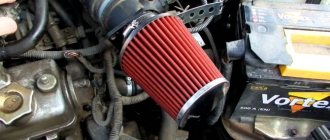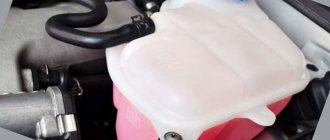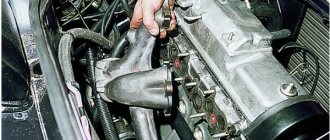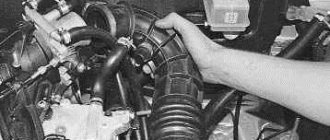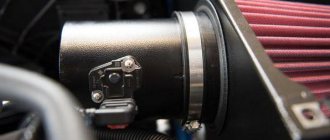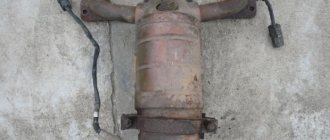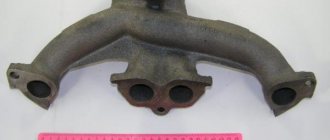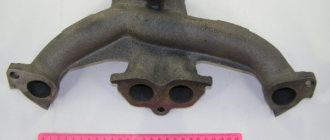“Kalina” is a symbol of the domestic automobile industry, of course we are talking about a car. In 2004, the first copy rolled off the assembly line. Until 2013, the car was not subject to changes or restyling. Everything was the same, no improvements. Few people paid attention to the model and preferred foreign options. But after 2014, everything changed dramatically. The exterior and interior have changed significantly; The designers took into account the clients' comments.
The machine is manufactured in various variations. The engine is equipped with a direct injection system and electronic ignition. The body structure strictly complies with basic safety standards. Maneuverability has been increased by shortening the overall body length. Since the beginning of 2012, all Kalina models have been equipped with an electronic gas accelerator pedal.
Among the bulk of frequent breakdowns and shortcomings, many owners experience difficulties when the standard catalytic filler fails. Using the example of a Lada Kalina with an 8-valve engine, we will consider the algorithm for removing and replacing the seal.
The main reasons for replacing the catalyst gasket
One of the main reasons for catalytic converter failure is that the exhaust channels become clogged. The formation of plugs leads to the deposition of soot, soot, and other solid deposits. Sources of clogging can be:
- low quality fuel;
- the use by the owner of the technical equipment of all kinds of chemical additives in the combustible mixture (these reagents only have a detrimental effect on the performance of the fuel system);
- possible mechanical damage to the housing or internal connections;
- long-term operation without replacement or prevention;
- faulty engine ignition system;
- unstable operation of the oxygen sensor, due to which the combustible mixture is lean or enriched, which also has an extremely detrimental effect on the performance of the entire system.
Intake manifold
Due to the large area of joints that require sealing, the option of plastic welding is immediately rejected - it is too expensive. You may be puzzled by sealing the cracks yourself using a soldering iron. But, since we have a low-volume naturally aspirated engine, it is quite enough to apply sealant along the joints.
Before carrying out work, we check whether air is being sucked in problem areas. As it turns out, the gaps were so large that pouring brake cleaner on caused the engine to convulse!
Replacing the Kalina catalyst gasket (8 valves)
Replacing the catalyst gasket on an 8-valve Lada Kalina begins with the preparatory stage: a set of tools, socket heads, rags, heat-resistant sealant, a new gasket - seal.
Dismantling work affects both the engine compartment and the underbody of the car. The service station master starts with the hood space:
- Opens the hood and removes the decorative plastic engine cover. Unscrews the four rubber clips located around the perimeter, as well as the plastic oil filler cap.
- Be sure to reduce the pressure in the fuel system of the power unit. To do this, you need to turn off the engine, remove the fuses from the block in the tunnel, and start the engine. Let it run again until all the fuel is used up, then insert the fuses.
- Resets the negative terminal from the battery.
- Removes the injection module. Unscrews the standard fasteners around the perimeter with a figured screwdriver.
- Disconnects the contact board of the wires from the fuel injectors and the engine, and moves the gasoline supply hose to the side.
- Disconnects the catalyst from the standard pipe of the additional muffler. Removes the rubber suspensions and the receiving pipe flange from the seat.
- Disconnects the contact group of oxygen sensor wires.
- Unscrews the heat-insulating shield from the motor housing.
- Unscrews the inlet pipe from its seat.
- Removes the spacer and damper tube.
- On the body part of the exhaust manifold, unscrew two nuts and remove the heat-insulating shield.
- Unscrew the six fastening nuts around the perimeter of the manifold, dismantle the inlet pipe of the cylinder head.
- Directly removes the sealing gasket itself from the block head.
- Use fine sandpaper to clean the perimeter of the cylinder head from remnants of the previous gasket.
- Conducts visual diagnostics of removed equipment and components.
Removing the engine receiver
Removing the receiver of the VAZ-21114 Lada Kalina engine
Remove the throttle assembly (see “Removing the throttle assembly”).
Using a 10mm socket, unscrew the three nuts securing the throttle drive cable bracket.
We remove the bracket and move it with the cable to the side.
Use a slotted screwdriver to loosen the band clamp securing the vacuum brake booster hose.
. and remove the hose from the receiver pipe.
Using a 13mm socket, unscrew the nut securing the left receiver to the intake pipe. Unscrewing four more nuts.
. remove the receiver from the intake pipe studs.
Sealing gaskets are installed in the grooves of the receiver flange. If additional work is required after removing the receiver.
. It is necessary to cover the holes in the intake pipe with a rag to prevent foreign objects from entering the engine. Before installing the receiver, we check the condition of its sealing gaskets. If the gasket has lost elasticity or is damaged, it must be replaced with a new one. Install the receiver in reverse order.
Video on the topic “Lada Kalina. Removing the engine receiver"
Replacing the receiver on a VAZ 2114, Kalina
Dismantling the intake manifold on a 16 valve Kalina Lada Kalina, Priora. How to remove the intake manifold without removing the engine on a 126 engine (16 valves)
Source
Replacing the Kalina catalyst gasket: installation and assembly
After a new paronite gasket with a metal ring in each hole has been prepared, the catalyst is replaced and the technician begins reassembly.
It is recommended to install asbestos-paronite gaskets with a metal frame inside to increase the service life of the product. Compared to a similar gasket, the service life with a metal ring is twice as long.
Further assembly is carried out as usual. There is no need to apply a heat-resistant sealant to the gasket, since there is a high probability of chemical residues getting into the combustion chamber and clogging the channels. The consequences can be very diverse and unpredictable.
There is a modification of the Lada Kalina with a 16-valve system. The gasket replacement algorithm is completely identical to the 8-valve one, there are no differences.
Intake manifold
A new collector costs about 7,000 rubles in online stores. Such a high price tag for a unit for a domestic car is associated with its design features. It has built-in dampers of a system of variable channel lengths. And the manifold of the 127th engine itself is more voluminous and massive in comparison, for example, with the manifold for the 126th Priora engine. Buying a new unit is not our method.
Alas, studying the diagrams was upsetting. This collector is non-separable. The experiment with forced halving seemed too dangerous due to the presence of dampers. In addition, this would require removing the manifold, and on a 127 engine this is quite labor-intensive. Therefore, it is easier to get away with local repairs.
Signs of damage
Problems in operation are immediately noticeable. The first sign is the engine starting and stopping, or no start at all. In a service station, diagnostics are performed by a specialist. The oxygen sensor is unscrewed from its seat and the technician tries to start the engine; if it works the first time, then the reason is the catalytic filler and the tightness of the system. Otherwise, the reason lies elsewhere.
Secondary signs: reduced dynamics of vehicle acceleration, average speeds are reduced, fuel consumption increases, the “CHECK ENGINE” error indicator lights up on the central instrument panel.
The above symptoms may not always objectively indicate the exact cause of the breakdown. Auto mechanics recommend using several at the same time. For example, increased fuel consumption may not always indicate a problem with the exhaust system. There are many related breakdowns that can give such a symptom.
In 99% of cases, a clear whistle in the area of the engine compartment is guaranteed to identify the breakdown. Of course, if a turbine is not installed. But it is not provided in Lada Kalina.
Replacement process
The replacement process itself on the Kalina 8 cl unit is simple and can be carried out under normal conditions, in the most ordinary garage with good lighting. When dismantling, place all removed parts in some previously prepared container so as not to lose anything. If the car has high mileage, you may need to purchase new bolts for tightening. But it will be possible to say more definitely after dismantling the head.
Required Tools
Stages
At this point, the replacement of the cylinder head gasket on Kalina with an 8-cl unit is completed. The process cannot be called simple, but requires special care and accuracy. If, after reading the material and viewing the photo gallery, you still have questions, watch the video material.
Untimely gasket replacement: dangers and risks
The main danger lies in the excessive formation of carbon deposits and its deposition on the exhaust system channels. The second point: ceramic honeycombs are destroyed over time, their fragments are spread under pressure throughout the entire system. This is very dangerous, since the particles block circulation and contribute to damage to internal mechanisms: timing belt, spark plugs. The most dangerous option is when fragments of ceramic honeycomb penetrate the oil pan and mix with the engine oil. Subsequently, this mixture damages the surface of the cylinder walls. The car loses compression, breaks down, and needs partial or major repairs.
Technical features of the insert
Installing catalyst replacements can eliminate the problem of a clogged exhaust filter and return the car to its previous performance - power and gas mileage. But what are these substitutes? This insert is a hollow pipe that does not have filters. It is made in the form of a catalyst and in most cases there are no problems with its installation. After installing the insert instead of the factory exhaust gas filter, drivers observe:
- acceleration of warming up of the car in the cold season;
- the car picks up speed better;
- fuel consumption is reduced.
In some cases, there is a change in the sound volume when the car is running. The sound becomes more bassy. The Lada Kalina computer can display “Check” on the dashboard when driving with the insert. To prevent this, use a lambda probe or oxygen sensor. This sensor is an integral part of the exhaust system with a catalyst. The sensor analyzes the level of oxygen and harmful gases in the exhaust and transmits the information to the on-board computer. Based on the data obtained, the computer determines the performance of the catalyst. The lambda probe cannot be repaired; if it breaks, the part must be replaced.
Since the insert does not reduce the level of toxic substances in the exhaust, the lambda probe will constantly transmit information about a catalyst malfunction. To avoid this, special devices are used - decoys. They come in two types: mechanical and electronic.
Lambda zone deception
Mechanical blende is a bronze spacer of a certain size, filled with ceramic chips coated with a catalytic layer. Exhaust gases pass through the small holes of the device, interacting with the crumbs, due to which the CO2 concentration is reduced. Electronics analyzes the changes and sends information to the computer about the normal operation of the catalyst.
Electronic snag is a high-tech device based on a single processor. Such a device analyzes the operation of the exhaust gas purification system and transmits information about the serviceability of the catalyst. The electronics understand that smog filtering is not happening, but generates a signal corresponding to the correct functioning of the system.
Installing electronic deception involves reflashing the computer to exclude from its code the calculations of dosage corrections transmitted by the rear oxygen sensor. The program does not save records of catalyst operation errors in the computer memory.
You can replace the catalyst with an insert in many car repair shops. Self-replacement is recommended only if you have the appropriate tools, skills and experience. You can install electronic deception yourself, but you need to have a good understanding of the principles of computer operation and have the necessary software. Otherwise, the car owner risks making the situation worse.
Reasons for removing and replacing the exhaust manifold Lada Kalina
The exhaust manifold is made of cast iron, which is very resistant to temperatures. However, a critical temperature - 800-900 degrees - can render the distributor unusable. In addition, there are many other factors that negatively affect it. This list can include:
- Mechanical damage;
- Loss of tightness at the junction with the cylinder head (cylinder block);
- Inoperative condition of the gasket between the BC head and the manifold;
- Due to constant overheating, cracks or warping may occur.
Sometimes replacing the exhaust manifold on Kalina 8 valves is necessary in order to install a more advanced and high-quality part.
Important! The exhaust manifold gasket is created from pressed reinforced asbestos and is necessary to create a tight connection between the BC head and the distributor. The fact is that the BC head is made of aluminum, and the manifold is made of cast iron. Therefore, under the influence of temperature, these two elements expand and contract differently. And asbestos allows you to coordinate the difference in thermal expansion. The main threat to the gasket is constant exposure to high temperatures.
There are a number of symptoms that will tell you that you need to replace the exhaust manifold of your Lada Kalina:
- In any operating mode, the engine makes an unpleasant characteristic sound;
- Exhaust gases enter under the hood or even into the interior of your car;
- The engine loses power due to a mismatch between the BC head and the manifold.
Intake manifold
Oil traces at the manifold joints are visible to the naked eye, and air leaks can be calculated using a simple technique. While the engine is running, spray any suspicious areas with brake system or carburetor cleaner. If after some time the engine speed “floats” or it begins to choke altogether, then there is a significant suction in these places. The cleaner, as a flammable substance, entering the intake, enriches the air-fuel mixture, which causes the engine speed to fluctuate.
The intake of additional air, not taken into account by the sensors on the intake side, causes a constant leaning of the mixture. The control system tries to adjust the fuel supply based on the output readings of the front lambda probe. As a result, we have the notorious engine trim at idle speed.
Required tools and materials
The list of what is needed is, in principle, standard: a standard set of tools, an extension cord with various heads, WD-40 or other similar lubricant. If you know that the problem is broken studs, then a stud extractor, taps, drill and drill bits will be added to the above list. In addition, a bucket or basin, possibly an old canister, should be at hand.
Advice! A few days before replacing the exhaust manifold, you can begin to lubricate all fasteners in the system. Can be lubricated several times a day. This will greatly simplify the task and make replacement quick.
Gasket selection
When purchasing a gasket, you need to know the type of engine installed on Kalina. There are two versions of 8-valve engines - VAZ 11183 and VAZ 11186. These engines have different piston groups and differ in many external elements. On the older version 11183, a thickness of 1.2 mm is used (article 21080-1003020-12, manufacturer ZAO Lada-Image), and the new 11186 requires a gasket with a thickness of only 0.43 mm. This nuance must be taken into account when choosing new parts. For a 1.4-liter 16 valve engine, a gasket 11194-1003020-00 manufactured by Federal-Mogul Corporation is required, or you can get a cheaper option from Trialli (GZ1015001).
Dismantling
There is only one difficulty in this process - the inaccessibility of some fasteners. It is best to carry out this “operation” in a viewing hole or on a lift. Of course, this is not necessary, but it is much more convenient.
Work order:
- First you need to remove the negative terminal from the battery or turn off the mains switch.
- Next, it is recommended to drain all the antifreeze into a container prepared in advance.
- Next, you need to disconnect the fuel pipes. If the coolant is not drained, at this stage it will go into the cylinders.
- Now you have to find the throttle position and idle speed sensors, and then remove the wires from them.
- We first remove the crankcase ventilation from the hoses, then the brake booster.
- Remove the intake manifold (receiver) together with the throttle assembly.
- Then remove the fuel rail (without disassembling) and the wires from the injector.
- There's not much left. Now you need to remove the heat reflecting screen. The exhaust pipe of the muffler is unscrewed from the manifold.
- We remove the exhaust manifold Kalina 8 valves from the BC head studs, to do this we unscrew the fastenings shown below in the figure
How to remove the engine head on a viburnum
Domestic cars cannot boast of such reliability as foreign cars and therefore, in order to save on their maintenance, the car owner has to do many of the works himself. Replacing the Kalina 8 valve cylinder head gasket can be done with your own hands and you do not need to be a high-class auto mechanic.
The cylinder head gasket on an 8-cl engine cannot be called a weak point in the car’s design. But still, even with careful operation of the vehicle, there may be a need for replacement. You can do it yourself, but if you are hesitant and want to take on this work for the first time, then invite a friend who has experience in similar work (replacing the cylinder head gasket). Be sure to carefully read the material we offer and you will definitely succeed. Let’s say right away that replacing the cylinder head gasket on Kalina units with 8 cl and 16 cl is very similar, but there are some nuances regarding the tightening of the cylinder head bolts. Therefore, be careful.
Replacing the exhaust manifold and gasket
When dismantling the manifold, the gasket is destroyed in almost any case. Therefore, it is worth removing its remains from the parts. Replacing the Kalina exhaust manifold gasket is a simple process. The use of sealants and other third-party substances is not recommended. They may later get into the crankcase.
Replacing the manifold itself is simple - just take a new part and install it according to the principle in which it was attached. Assembling the system is simply the reverse order of the steps outlined in the last section.
Advice! Don't forget about cleanliness. This is an important factor in long and trouble-free operation of the car.
Check Engine
Constructive
Metal intake manifolds are cast as a single unit or made into multiple parts. In the latter case, the connections are sealed with sealant or gaskets are installed. Accordingly, they can always be updated by halving the composite manifold.
Plastic collectors are always composite. Production technologies do not allow producing such units as monolithic ones. In most cases, such collectors are actually non-separable: the joints of the connections are soldered. Although there are still more thoughtful designs with the ability to painlessly separate into parts and replace rubber gaskets.
The design of a specific manifold and the possibility of replacing gaskets or updating sealant can always be seen on diagrams, which, for example, are in spare parts catalogs on the websites of well-known online stores.
In this article we will look at working with the engine of a new Kalina Cross, whose owner, Dmitry, came all the way from the Khanty-Mansiysk Autonomous Okrug! Of course, he didn’t come specifically for one tuning, it was just an element of a big trip.The car is new, the mileage is only 16 thousand km. Equipped with a new VAZ 21127 engine with variable intake tract geometry .
Let's briefly look at the “new” engine 21127 . It is “new” in quotation marks. In fact, this is the same 21126 Priora engine, with the same volume of 1.6 liters, on which they hung a new receiver with “variable” intake tract geometry, and replaced the MAF with a DBP (absolute pressure sensor). The car is equipped with an M74.5 , the fuel rail and injectors have also changed. The plant declares an increase in power to 106 hp. and torque up to 148 Nm . We will look at the issue with the inlet receiver in more detail later in the article.
We were not given the task of making global tuning. As the client put it, “it was necessary to finish the car after the Cross” and it’s a marketing fool. Multi-cone synchronizers are still quite alive (the mileage is small), but our secondary shaft has an 08 design and we will install synchronizers of a new type with 6 hooks. At the client's request, Motul oil was added, especially for locking boxes.
Only the most ardent vase-haters would deny that the quality of the “Boo Anderson era” car has increased significantly. This also applies to the build quality and the quality of materials used in the cabin. The author, as the owner of the first Kalina, really liked the new car.
The new 127 receiver presents great difficulties in installing it directly in the engine compartment. If the 126 receiver on Kalina can be removed without any problems (with preliminary removal of the fuel rail), then the 127 receiver cannot be removed so easily. To dismantle it on Kalina, you need to unhook the rear engine mount and tilt the engine back!! The plant has reached the unforgettable Samara “Superauto” with a 16-valve valve!! Otherwise, working with the engine is nothing new. We dismantle the connecting rod and piston group (the connecting rod bearing is covered with some debris, but the crankshaft is ideal), and replace the plug-in pistons with plug-in ones . At the same time we change the rings. The quality of the factory hone leaves much to be desired (a mere file), but the cylinders are in perfect condition and we will not force the client into spending money on dismantling the block and rehoning it onto the plateau.
There is very little work to do with the head - wash it, clean off the factory glue. Factory caps with a mileage of 16 thousand km do not need to be replaced at all. We reground the factory hydraulic compensators with spherical RS pushers, and replace the camshafts with regrinding ones with a lift of 8.7 mm and a phase of 264 degrees . As the author has previously written repeatedly in reports, the shafts are made by regrinding from factory ones, do not require thrust bearings, are placed on factory pulleys, and spherical pushers additionally calm and stabilize the idle speed (it remains at factory values).
After starting the engine, the client left to unsubscribe from the individual program.
Now it's time to talk about the receiver. The appearance of 21127 engine was perceived by the tuning community as a kind of revolution. At first, receivers stolen from the assembly line managed to sell for 40 thousand rubles! People still think that the 127 receiver is better and more powerful than the 126 from Priora. Some drivers manage to change the 126 receiver to a 127 by replacing the wiring with the controller, or by powering the pneumatic valve from the auxiliary legs of the controller. The chip guy long ago formed his opinion about the receiver - he had experience replacing the receiver, streamer and controller on the 126 engine with components from the 127 engine. The result of the work is that the engine ran worse . Since the air consumption with DBP is unknown, and the chipmaker does not take VSKh graphics, the opinion was drawn up very simply - the time for opening the fuel injectors after replacing the receiver and unsubscribing the program was reduced . Consequently, after such a replacement the engine began to take in less air. Why is this happening? It's simple. This receiver was created by the factory not at all for the power purposes of “tuners”, but to change the torque characteristics in order to make its curve smoother and smoother.
We can also mention DBP , the implementation of which is a real savings on components (mass air flow sensor is much more expensive). It is more difficult to write down a complete program, because... air flow is calculated by the controller based on the mathematical model (there is little benefit from MDA on an atmospheric engine). With light tuning (such as the current work with “light” shafts, without changing the engine size), it is possible to work with the program, because the actual air flow does not exceed the theoretical factory ceiling, which is included in the program with a margin. But an increase in volume and angry shafts with gashed channels will already provide big problems in unsubscribing the program on such a configuration (DBP), due to the fact that the real air flow goes beyond the boundary prescribed in the mathematical model. And editing a mathematical model is quite a task. But let’s leave this question outside the scope of this article for now, limiting ourselves to just saying that such a car (a 127 engine with a capacity and a head full) is already in the immediate queue and these problems will have to be solved. One can only sympathize with the rest - the plant played a real trick on the tuners. However, for people who understand little about tuning and unsubscribing programs, these will all be empty words - the Shmaulus will write everything out for them.
Let's return to the receiver. How is the correct variable geometry receiver made on foreign cars? There is a short path, there is a long one. There are a number of dampers that close one or another path into the common throttle space. You can look at photographs of a disassembled Opel Vectra receiver, where the author repaired the dampers, or at photographs of a Ford S-Max receiver, where the receiver is a twisted ram's horn. It has only one path - a long one and there are dampers in the middle of the path connecting it to the throttle volume of the receiver. It is this “ram’s horn” that gives a real increase in air consumption at the top while reducing the length of the intake tract. But VAZ is too lazy to remodel the body, the entire engine, to implement the correct intake receiver with variable geometry. That’s why lazy people came up with an “ersatz receiver”, essentially a cheap-to-make decoy. A hat was placed on the long 126 receiver in the middle of the long tract, inside of which the dampers are hidden. These dampers simply connect the intake channels of the receiver to each other in the middle part of the intake tract. In this case, this intermediate “middle” volume is connected to the after-throttle space through the upper part of the long path (although it must be directly connected to the after-throttle space). It turns out to be two separated receiver volumes with intermediate pipes. In practice, there is a slight smoothing of the torque graph, which is convenient in civilian use (the characteristic Prior torque undermining from the 126 receiver after 4500 rpm is leveled out). However, such an ersatz receiver strangles the engine , increasing resistance to air flow, and worsens its filling, which was noticed by the chipmaker when replacing the 126 receiver with a 127 receiver to reduce the opening time of the fuel injectors (the iron part of the engine did not change).
After this theoretical introductory part, it is time to move on to the analysis of the 127 engine graphs. The first measurement is a serial configuration of the engine with a catalytic collector, the controller has already been flashed by a certain Ruslan (in fact, the usual Shmaulus). In terms of power, the engine has not reached more than 100 horsepower; in terms of torque, factory values have been achieved. Noteworthy is the drop in torque in the 3500 rpm zone (the client felt it to the fullest and it appeared after chiptuning).
peak power: 99 hp at 5100 rpm (red line), peak torque: 14.9 kg at 4500 rpm (blue line).
After installing the 8.7 shafts, replacing the pistons and unsubscribing from the program, we took the schedule again. The dip in the moment disappeared completely, the graph of the moment leveled off. The engine became more powerful, but not as much as expected.
peak power: 110 hp at 5900 rpm (red line), peak torque: 15.1 kg at 4700 rpm (blue line).
Let’s compare the “was/has become” graphs. Up to 3000 rpm we lost 1.5 kg of torque, leveled out the torque slack and added it mainly at the top. It’s impossible to say how much was added at 6000 rpm, because... The “before” graph was measured in the range up to 5500 rpm. Frankly speaking, we were hoping for better results. The engine seems to have a gag, something is holding it.
And the graph reminds me of something...
Well, of course! This is the notorious Kalina Sport II with a serial lower end of 1.6 and a plastic receiver of 126!! The graph is like two peas in a pod to the result with which the car was delivered after the first stage of engine tuning, having concluded that it was impossible to achieve a high result without overhauling the engine (which was later fully justified at the second stage of engine tuning). Well, let's compare!
These are the twins... The red dotted line is the Kalina Cross engine with 8.7 shafts and a 127 receiver , the thick lines are Kalina Sport II with Lada Sport shafts and a 126 receiver . The mileage of the engines is almost the same (Cross - 16 tkm, Sport II - 10 tkm), factory assembled 1.6 lower end with a rough hone. The cars were sewn by the same person, the difference is also in the pistons (on Kalina Cross the pistons are seamless).
Since the hardware is still different (the difference is in pistons, shafts, brains, and the fact that Kalina Sport already had a sawed-off head by that time), the author will refrain from directly comparing cars in the spirit of “127 res is worse than 126”, because . this could be clearly deduced only from comparing receivers on the same engine (as the chip manufacturer did in his time). But the author still drew conclusions for himself.
Of course, if we reassembled the “bottom” of the engine and increased its volume, the results could be much better, with the same 127 receiver.
The owner of the car sent a comment (I quote the letter in full below) on the results of the tuning. The words about a “hurricane” are, of course, a clear exaggeration (although, depending on what you compare with, this is what happens after Shmaulius). Row noise (“rumble”) is a common phenomenon and decreases over time.
Artem, good day! A little about the car and my feelings. The car is a hurricane, compared to what it was before I met you and Sergei. On the highway you feel confident when overtaking and on mountain climbs, it drags as if it were caught on a locomotive. At the moment, the mileage is 2600 km, in terms of consumption : on the highway, with sharp accelerations and revs up to 4500 from 7.6-8.4 l/100 km, in the city, it’s difficult to say, because I move mainly in 1st and 2nd gear with rpm of 3000-3500, the city is small, there are a lot of cars, and everything floats. Consumption ranges from 8.7 to 13 l/100 km (it also jumps out at 15-17 l/100 km), this is according to the computer, it feels like the consumption is less than at stock. I’m slowly getting used to the rumble in the gearbox, but it still strains my hearing a little, especially at idle and 1st gear. It feels like the gears are not in order in a row, but are simply thrown into a heap and fly into the gearbox, not secured, sometimes the sound seems as if it is hitting something. In other gears, the noise has decreased, I would say that it has practically disappeared, compared to how it was. Yes, and one more thing, In our conditions, the consumption will in any case be higher and the dynamics will be slightly less, because We initially have a deficiency of oxygen in the air of up to 19%. I felt in the car, as soon as I crossed the Ural Mountains, the car started to become heavier and consumption on the highway increased to 9-10 l/100 km. Comfortable speed on the highway is 100-110 km/h at 3000-3500 rpm, the maximum torque was 150 km/h at 5000 rpm, picks up speed quickly, but the engine is still heavy and the receiver is suffocating, it feels like it’s hard for the engine to breathe. Well, something like that! In general, I am very pleased! Thank you very much and good luck in your business, and in life too!
Sincerely, Dmitry K. April 9, 2016
Article written: April 24, 2016 Author of the article, photo-video materials: © Quasar Prohibited without the written permission of the author: reprint of the article in whole or in part, reprint and use of photo-video materials, as well as their modification and editing for the purpose of further publication on third parties sites.
Video
The video shows the identification of the malfunction and the process of changing a broken gasket on Kalina (by Sdelaj Sam! Pljus interesnoe!)
Good afternoon or evening everyone))
It’s clear from the title what kind of repair this is,
but a little background
)) Two days ago I noticed that the stove was blowing cold, well, I thought that the system was just airy, I removed the plug and everything seemed fine.
The day before yesterday the same picture happened again, I immediately thought it was the RB cover or the head gasket was broken, well, so as not to get too upset, I first decided to change the cover. Since the topic is familiar and the symptoms
were eerily familiar, the car gets hot, the large circle does not open and when you press the gas, antifreeze runs into the barrel, heat begins to flow into the cabin after 2000 rpm. But, as always, I hoped for the best)) At the same time, I saw that antifreeze was leaking on the block, and the thermostat gasket was leaking. We go to the store with Noun174 and buy a thermostat cover, a thermostat gasket and a new thermostat, I bought the thermostat because of a cold bottom hem (there were hopes). I changed the RB cover right away, while I was driving home the car returned to normal, it stopped heating up and heat began to flow into the cabin)) I thought about a miracle, but in the garage everything worked fine, since it was necessary to fix the leak. New Old
Causes of malfunctions
The key factor that causes 90% of exhaust manifold malfunctions on VAZ 2114 cars is high temperature and poor quality materials from which the parts are made. During operation, the steel repeatedly heats up and cools down, which leads to the appearance of cracks in the body. This is a common occurrence for VAZ cars older than 7-8 years.
Auto repair shops offer crack welding services using argon welding. However, for a number of reasons, this activity is useless for cars older than 7 years.
1) Just removing and installing the exhaust manifold will cost about 2.5 thousand rubles. Taking into account the work of the welder and other actions, the cost of repairs can be 4-5 thousand rubles. If you do the work yourself, buying a new part will cost less.
2) Welding, even argon welding, disrupts the structure of “tired” metal. A boiled part rarely lasts longer than a year, after which new holes appear. The older the car, the faster the problem returns, and the collector has to be removed again.
If the car is older than 8 years and there are problems with cracks in the manifold, it is better to remove the part and replace it with a new one.
